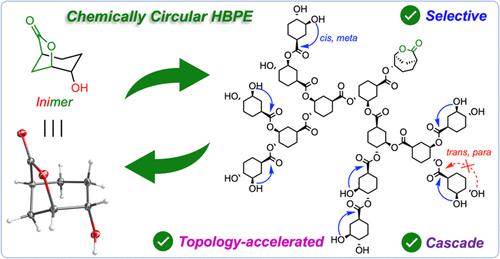当前位置:
X-MOL 学术
›
J. Am. Chem. Soc.
›
论文详情
Our official English website, www.x-mol.net, welcomes your feedback! (Note: you will need to create a separate account there.)
Topology-Accelerated and Selective Cascade Depolymerization of Architecturally Complex Polyesters
Journal of the American Chemical Society ( IF 15.0 ) Pub Date : 2024-03-22 , DOI: 10.1021/jacs.4c00526 Changxia Shi 1 , Nicholas A. Rorrer 2, 3 , Alexander L. Shaw 4 , Ryan W. Clarke 2, 3 , Bonnie L. Buss 2, 3 , Gregg T. Beckham 2, 3 , Linda J. Broadbelt 4 , Eugene Y.-X. Chen 1
Journal of the American Chemical Society ( IF 15.0 ) Pub Date : 2024-03-22 , DOI: 10.1021/jacs.4c00526 Changxia Shi 1 , Nicholas A. Rorrer 2, 3 , Alexander L. Shaw 4 , Ryan W. Clarke 2, 3 , Bonnie L. Buss 2, 3 , Gregg T. Beckham 2, 3 , Linda J. Broadbelt 4 , Eugene Y.-X. Chen 1
Affiliation

|
Despite considerable recent advances already made in developing chemically circular polymers (CPs), the current framework predominantly focuses on CPs with linear-chain structures of different monomer types. As polymer properties are determined by not only composition but also topology, manipulating the topology of the single-monomer-based CP systems from linear-chain structures to architecturally complex polymers could potentially modulate the resulting polymer properties without changing the chemical composition, thereby advancing the concept of monomaterial product design. To that end, here, we introduce a chemically circular hyperbranched polyester (HBPE), synthesized by a mixed chain-growth and step-growth polymerization of a rationally designed bicyclic lactone with a pendent hydroxyl group (BiLOH). This HBPE exhibits full chemical recyclability despite its architectural complexity, showing quantitative selectivity for regeneration of BiLOH, via a unique cascade depolymerization mechanism. Moreover, distinct differences in materials properties and performance arising from topological variations between HBPE, hb-PBiLOH, and its linear analogue, l-PBiLOH, have been revealed where generally the branched structure led to more favorable interchain interactions, and topology-amplified optical activity has also been observed for chiral (1S, 4S, 5S)-hb-PBiLOH. More intriguingly, depolymerization of l-PBiLOH proceeds through an unexpected, initial topological transformation to the HBPE polymer, followed by the faster cascade depolymerization pathway adopted by hb-PBiLOH. Overall, these results demonstrate that CP design can go beyond typical linear polymers, and rationally redesigned, architecturally complex polymers for their unique properties may synergistically impart advantages in topology-augmented depolymerization acceleration and selectivity for exclusive monomer regeneration.
中文翻译:

结构复杂聚酯的拓扑加速和选择性级联解聚
尽管最近在开发化学环状聚合物(CP)方面已经取得了相当大的进展,但当前的框架主要集中于具有不同单体类型的直链结构的CP。由于聚合物性能不仅取决于成分,还取决于拓扑结构,因此将基于单一单体的CP系统的拓扑结构从直链结构控制为结构复杂的聚合物可能会在不改变化学成分的情况下调节所得聚合物的性能,从而提高聚合物的性能。单一材料产品设计的概念。为此,我们在这里引入了一种化学环状超支化聚酯(HBPE),它是通过合理设计的带有侧羟基(BiL OH)的双环内酯的混合链增长和逐步增长聚合而合成的。尽管其结构复杂,该 HBPE 仍表现出完全的化学可回收性,通过独特的级联解聚机制显示出 BiL OH再生的定量选择性。此外,HBPE、 hb -PBiL OH及其线性类似物l -PBiL OH之间的拓扑变化所引起的材料特性和性能的明显差异已被揭示,其中支化结构通常导致更有利的链间相互作用,并且拓扑放大还观察到手性 (1 S , 4 S , 5 S ) -hb -PBiL OH具有光学活性。更有趣的是,l -PBiL OH的解聚通过意想不到的初始拓扑转变为 HBPE 聚合物,然后是hb -PBiL OH采用的更快的级联解聚途径。总的来说,这些结果表明CP设计可以超越典型的线性聚合物,并且合理地重新设计、结构复杂的聚合物因其独特的性能可以协同地赋予拓扑增强解聚加速和专有单体再生选择性方面的优势。
更新日期:2024-03-22
中文翻译:

结构复杂聚酯的拓扑加速和选择性级联解聚
尽管最近在开发化学环状聚合物(CP)方面已经取得了相当大的进展,但当前的框架主要集中于具有不同单体类型的直链结构的CP。由于聚合物性能不仅取决于成分,还取决于拓扑结构,因此将基于单一单体的CP系统的拓扑结构从直链结构控制为结构复杂的聚合物可能会在不改变化学成分的情况下调节所得聚合物的性能,从而提高聚合物的性能。单一材料产品设计的概念。为此,我们在这里引入了一种化学环状超支化聚酯(HBPE),它是通过合理设计的带有侧羟基(BiL OH)的双环内酯的混合链增长和逐步增长聚合而合成的。尽管其结构复杂,该 HBPE 仍表现出完全的化学可回收性,通过独特的级联解聚机制显示出 BiL OH再生的定量选择性。此外,HBPE、 hb -PBiL OH及其线性类似物l -PBiL OH之间的拓扑变化所引起的材料特性和性能的明显差异已被揭示,其中支化结构通常导致更有利的链间相互作用,并且拓扑放大还观察到手性 (1 S , 4 S , 5 S ) -hb -PBiL OH具有光学活性。更有趣的是,l -PBiL OH的解聚通过意想不到的初始拓扑转变为 HBPE 聚合物,然后是hb -PBiL OH采用的更快的级联解聚途径。总的来说,这些结果表明CP设计可以超越典型的线性聚合物,并且合理地重新设计、结构复杂的聚合物因其独特的性能可以协同地赋予拓扑增强解聚加速和专有单体再生选择性方面的优势。



























 京公网安备 11010802027423号
京公网安备 11010802027423号